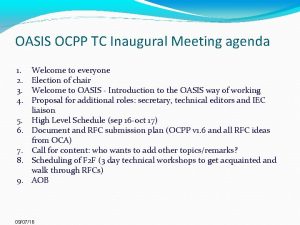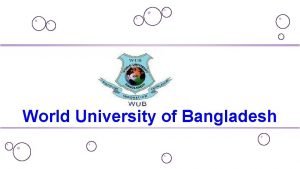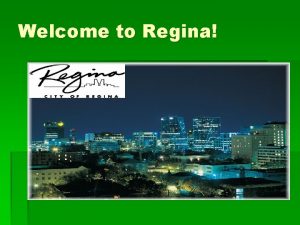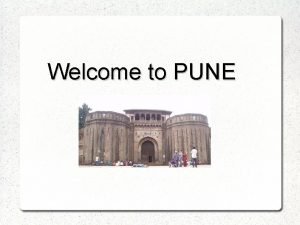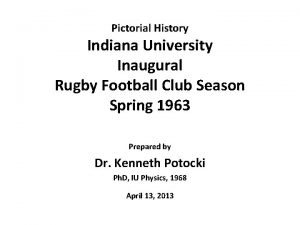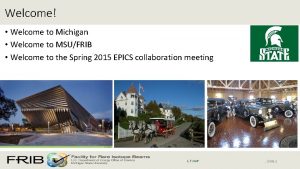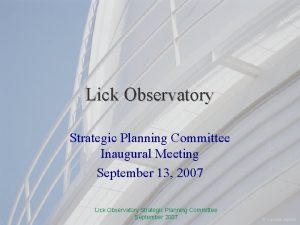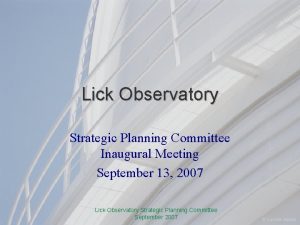UNIVERSITY OF UYO WELCOME TO THE TH INAUGURAL


















































































- Slides: 82

UNIVERSITY OF UYO WELCOME TO THE TH INAUGURAL LECTURE 17 TH UNIVERSITY OF UYO by PROFESSOR IMOH E. UKPONG (Professor of Biogeography). . Biogeographer, Mangrove Ecologist &Vegetation Scientist, Coordinator Uniuyo/Lancaster Higher Education Link and Former Dean of Social Sciences… DEPARTMENT OF GEOGRAPHY & REGIONAL PLANNING UNIVERSITY OF UYO NIGERIA

MANGROVE FORESTS UNDER THREAT?

DEDICATION This Inaugural Lecture is dedicated to ALL RESEARCH SCHOLARS and lovers of Knowledge.

MANGROVE FORESTS UNDER THREAT? AN EVALUATION OF THE INTEGRITY OF MANGROVE ECOSYSTEM FUNCTIONING PROFESSOR IMOH E. UKPONG (Professor of Biogeography) …Biogeographer, Mangrove Ecologist & Vegetation Scientist, Coordinator Uniuyo/Lancaster Higher Education Link and Former Dean of Social Sciences… DEPARTMENT OF GEOGRAPHY & REGIONAL PLANNING UNIVERSITY OF UYO NIGERIA

1. 0. Definition of Mangrove INTRODUCTION The term mangrove generally applies to: An association of trees [including associated micro-organisms e. g. bacteria, fungi, algae, and fauna, e. g. molluscs, crabs, shrimps and fish] which live in wet, loose soils in tropical tide waters. The term also applies to certain species of trees which occur in such an association. “Mangrove” is normally restricted to those species of trees which possess either pneumatophores or viviparous fruits or both (these are coping mechanisms due to the extreme environmental factors of high salinity, fluctuating water saturation and anaerobic substrates). The word “mangrove” is used when reference is made to individual kinds of trees, while the word “mangal” may be used with reference to the swamp forest community. The mangrove flora is very specialized and consists of shrubs and trees of relatively few genera and about thirty species. Two classes of plants make up the mangrove vegetation: Genera and higher taxa found only in the mangrove habitat Species that belong to genera of inland plants but which have become adapted to life in the swamps.

Table 1. 1: Some families, genera and species represented in mangrove vegetation (after van Steenis 1962, Chapman 1976) FAMILIES GENERA SPECIES Rhizophoraceae Rhizophora R. R. Bruguiera B. gymborrhiza B. sexangula B. cylindrica Ceriops C. tagal C. decandra Kendelia K. candel Sonneratiaceae Sonneratia S. casedaris S. ovata S. alba Avicenniaceae Avicennia A. A. A. Combretaceae Lumnitzera Laguncularia Conocarpus L. racemosa C. erecta Palmae Nypa N. fruticans Oncosperma O. horridum Phoenix P. reclinata P. paludosa Euphorbiaceae Excoecaria E. agalloacha Polypdiaceae Acrostichum A. aureum A. specosum Acanthaceae Acanthus A. ilicifolius A. ebracteatus A. speciosum racemosa mangle harrisonii mucronata germinans(A. nitida) danata alba marina bicolar africana

1. 2 General distribution pattern Mangroves are best developed in extent and variety of trees when bordering the coastal margins of the tropical rain forest. Geographically, two broad groups of mangroves are recognized: Europe N. America a si A Africa S. America st a E h ut o S Australia Fig 1. 2 World distribution of mangroves • The Indo-Pacific mangrove region extending from East Africa through Southeast Asia to New Zealand the Southern Archipelago of the pacific from Samoa. • The West Africa-Americas mangrove region extending from the Atlantic coast of Central Africa, through West Africa and America, excluding Hawaii but including the Galapagos

1. 3. The Biogeography of mangroves Mangrove habitat is exclusively tropical, subtropical and tidal The habitats have soil or sediment that are waterlogged, saline or of variable salinity Mangroves occur in river estuaries, lake shores or marine shorelines The habitat contains a variety of plant species. About 54 species in 20 genera belonging to 16 families constitute true mangroves Evolutionary convergence has resulted in increased adaptations of species to variable salinity, tidal inundation and anaerobic soils. Red mangroves (Rhizophora spp) prop themselves above the water level with stilt roots and breath through lenticels. Fig 1. 3 Red mangroves (Rhizophora spp)

1. 3. The Biogeography of mangroves: Contd. l Red mangroves have impermeable roots which act as ultra-filtration mechanism that exclude sodium salt from the rest of the plant l Black mangroves (Avicennia spp) occur on higher topography and posses pneumatophores or aerial breathing roots covered with lenticels Fig 1. 4 Black mangroves (Avicennia spp)

1. 3. The Biogeography of mangroves: Contd. l Between 90% - 97% of salt is excluded at the roots of Avicennia spp before water uptake into the mangrove tissues (the remaining salt accumulate in old leaves which are then shed or are safely stored in cell vacuoles) l White or Grey mangroves (Laguncularia racemosa) secrete salt directly from glands located at the leaf base. l There about 18 million ha of mangroves in the world. Thirty-five percent occurs in SE Asia. Indonesia alone has 4. 5 million ha. Fig 1. 5 White or Grey mangroves (Laguncularia racemosa)

l l 1. 3. The Biogeography of mangroves: Contd. Nigeria contains the third largest area of mangroves in the world Indigenous species in Nigeria are Rhizophora racemosa, Rhizophora mangle, Avicennia africana and Laguncularia racemosa which generally occur in this order along the zonation gradient from the river channels inland to the lowland freshwater swamp forest. Fig 1. 6 Nigerian shoreline Showing Mangrove Vegetation

1. 3. The Biogeography of mangroves: Contd. Mangrove area estimates in Nigeria has however remained a subject of debate, e. g. estimates of 540, 000 ha (Allen 1965); 999, 400 ha (Environmental Management Project 1977); 973, 000 ha (FAO, UNEP, 1980, 1981); 972, 826 ha (FAO 1980); 670, 000 ha (Hughes to Hughes 1982); 709, 800 ha (Moses 1985); 997, 700 ha (Environmental Management Project 1995); 1, 051, 500 ha (Spalding, Alasco & Field 1997); 1, 050, 000 ha (Aizpuru, Achard and Blasco 2000) have all been cited in the literature. For e. g. it is not likely that the national level of mangrove area in Nigeria could have increased from 540, 000 ha (Allen 1965) to 1, 050, 000 ha (Aizpuru et. Al. 2000)!! l l Most estimates are actually extrapolations. Available literature on the sources and projects for these estimates point to the lack of interest by researchers and environmentalists in verifying the accuracy of data/information for Nigerian mangroves l However, the estimates offered by Geomatics International in the Environmental Management Projects of 1977 (999, 400 ha) and 1995 (997, 700 ha) are perhaps the most authentic, having been based on remote sensing analysis. l Nevertheless, to say that the national level of mangrove has decreased by only 1, 700 ha in 18 years appears to be an underestimate. We believe that between 15, 000 - 20, 000 ha of mangroves are lost yearly to various uses in Nigeria l Obtaining accurate mangrove area estimate for Nigeria is a challenge to our GIS experts. We believe that it is possible to more accurate estimates of the mangrove area.

2. 0. 2. 1 THE MANGROVE SWAMPS OF SE NIGERIA General Characteristics: Fig 2. 1 Mangrove Swamps in SE Nigeria

THE MANGROVE SWAMPS OF SE NIGERIA: General Characteristics: l The alluvial mangrove swamps with luxuriant forests are found in the inter-tidal marginal estuaries of the Cross River[810 km 2], Kwa Iboe River[50 km 2], and Imo River[196 km 2]. l The swamps stretch approximately from longitude 7030 to 8030 East. l Between the Cross River in the east and Imo River to the west, the coastline is about 170 km long l The sandy coastal ridges along the Atlantic shoreline also carry mangroves, but mainly stunted, shrubs and strand species. l Semidiurnal tides alternate twice daily and cause tidal flow of the sea in and out of the mangrove swamps during high and low tides. l Tidal flushing may extend for more than 20 km upstream from the estuarine mouth e. g. from the Cross River estuary up to Creek Town. l At high tide average depth of water is approximately 6 metres. l Tidal amplitude is low, being approximately 2. 01 m at spring tides and 1. 07 m at neap tides (measured at Tom Shot Point at the month of the Cross River estuary). l Mean salinity value (for the Cross River) is 10. 80 PPT(Ramanathan 1981). However, a range of 2. 8 PPT at Calabar to 9. 5 PPT at the mouth of the estuary has also been reported (NIOMR 1986).

THE MANGROVE SWAMPS OF SE NIGERIA: General Characteristics Contd. l Wider salinity gradients ranging from 2. 3 PPT to 33. 35 PPT occur during the rainy season due to freshwater inputs (Ramanathan 1981). l Extensive mangrove growth occurs in the estuarine swamps of Imo River, Kwa Iboe River and Cross River. However, the Cross River swamp is the most complex in terms of species diversity. Species found include Avicennia africana, Rhizophora racemosa, Rhizophora mangle, Rhizophora harrisonii and Lagunchularia racemosa. l The important associes are Nypa fruticans, Raphia spp, Conocarpus erectus, Pandanus candelabrum, Phoenix reclinata and Acrostichum aureum l The Atlantic coastal sand ridges which separate the estuarine mangrove swamps from the ocean are themselves not continuous separated from each other by ebb-flood channels that permit ocean tides to inundate and flush the swamps. l Mangrove species on the beachridge sands occur as strand shrubs usually not more than 1 m tall e. g. A. avicennia and R. . racemosa. . Strand associes include Sesuvium portulacastrum, Ipomoea sp. , Paspalum vaginatum, Hibiscus tilaceus, Triumfetta rhomboideae and Cyperus articularis.

2. 2. Estuarine processes and landforms associated with mangrove growth in SE Nigeria. l The estuaries of SE Nigeria are all positive estuaries, i. e. freshwater inflow from upland streams exceeds outflow caused by evaporation. Therefore surface salinities are lower within the estuaries than in the open sea. This salinity gradient favours mangrove growth. l Due to subsidence and incision of the coastal areas of Nigeria during the ice age, the coastal sedimentary belt has drowned river estuaries. But due to recent sedimentation, bars or silt deposits which favour mangrove growth have developed along the mouths these estuaries l The major source of sediment is therefore the hinterland catchment and tributary rivers that empty their waters through the estuaries into the Atlantic Ocean l The Cross River (flowing over Precambrian Basement and Cretaceous – Tertiary Sedimentary rocks) is particularly endowed with sediments more that the Imo and Kwa Iboe Rivers, which account for the differences in the sizes of the estuarine swamps. l Within the estuaries, the substrates are different from that of the adjacent marine coast. Marine coasts are typically of sandy nature, while the estuarine areas are dominated by inter-tidal mudflats. l Differences in substrates and sedimentation account for the relative luxuriance of mangroves between the estuaries and the marine coasts.

2. 3. Physiographic mangrove habitats: l In SE Nigeria, mangrove species occurrences are identifiable with a number of physiographic habitats. The morphology of the habitats are shaped by the various fluvial processes that operate on the swamp landscape. l The habitats identified and generalised flood tolerance sequence of species are: i) Distributary channel habitat (DC) (R, racemosa > N. fruticans > A. africana > R. mangle > P. reclinate > Raphia)

2. 3. Physiographic mangrove habitats: Contd. ii) Point – bar habitat (PB) (R. racemosa > A. africana > R. mangle > N. fruticans > R. harrisonii > Raphia spp > P. candelabrum)

2. 3. Physiographic mangrove habitats: Contd. iii) Braided channel habitat (BC) (N. fruticans > R. racemosa > P. candelabrum > A. africana)

2. 3. Physiographic mangrove habitats: Contd. iv) Interdistributary basin habitat (ITD) (R. racemosa > A. africana > N. fruticans > R. mangle > D. lunatus > P. reclinata)

2. 3. Physiographic mangrove habitats: Contd. v) Wooded levee habitat (WL) (A. africana > R. racemosa > N. fruticans > R. mangle > R. harrisonii)

2. 3. Physiographic mangrove habitats: Contd. vi) Tributary creek habitat (TC) (A. africana > N. fruticans > R. racemosa > T. rhombodeae)

2. 3. Physiographic mangrove habitats: Contd. vii) Inter-riverine creek habitat (IRC) (A. africana > R. racemosa > P. candelabrum > R. mangle > R. hookeri).

2. 3. viii) Physiographic mangrove habitats: Contd. Beachridge strand habitat (BR) (A. africana/ R. racemosa/S. portulacastrum/I. Cairica/Remeira maritina) Mangrove species distribution and relationships among the hysiographic habitats are shown on Tables 3. 2(a) and 3. 2 (b) and 3. 2(c), while soil properties in the habitats are shown in Table 3. 3.

Table 3. 2(a) Density of overstorey mangrove species and associes (Density in stems/hectare) and significance of ANOVA tests among the physiographic habitats, (n): not significant, p > 0. 10; (*) p > 0. 05; (**) p > 0. 025. The habitats are: DC = Distributary channel; PB = Point-bar; BC = Braided channel; ITD = Interdistributary basin; WL = Wooded levee; TC = Tributary creek; IRC = Inter-riverine creek; BR = Beachridge. Parenthesis indicate number of stands in each habitat Physiographic Habitats Species (overstorey) DC (10) PB (8) BC (13) ITD (16) WL (13) TC (6) IRC (9) A. africana (*) 130 150 7 144 246 23 233 Nypa fruticans (**) 90 0 200 100 84 83 0 R. racemosa (n) 50 138 69 100 84 50 89 R. mangle (n) 50 75 54 63 84 100 56 Phoenix realinate (*) 40 0 7 100 0 20 11 Raphia spp (n) 60 50 0 6 7 2 0 R. harrisonii (*) 10 25 7 0 31 0 67 Other stems 110 25 177 56 0 100 33

Table 3. 2 (b): Density of understorey mangrove species and associes (Density in stems/hectare) and significance of ANOVA tests among the physiographic habitats, (n): not significant, p > 0. 10; (*) p > 0. 05; (**) p > 0. 025. The habitats are: DC = Distributary channel; PB = Point-bar; BC = Braided channel; ITD = Interdistributary basin; WL = Wooded levee; TC = Tributary creek; IRC = Interriverine creek; BR = Beachridge. Parenthesis indicate number of stands in each habitat Physiographic Habitats Specie s DC PB BC ITD WL TC IRC BR (understorey) (10) (8) (13) (16) (13) (6) (9) (5) 260 38 425 225 0 25 38 38 100 0 61 231 131 306 150 13 225 538 0 130 308 180 31 183 117 67 117 183 50 422 0 178 187 0 11 300 0 280 0 0 20 Avicennia africana (**) 230 Nypa fruticans (**) 110 Rhzophora racemosa (*) 270 Rhizophora mangle (n) 270 Triumfetta rhomboideae (*)0 Other stems 125

Table 3. 2(c) Density of groundlayer mangroves and saplings (Density in stems/hectare) and significance of ANOVA tests among the physiographic habitats, (n): not significant, p > 0. 10; (*) p > 0. 05; (**) p > 0. 025. The habitats are: DC = Distributary channel; PB = Point-bar; BC = Braided channel; ITD = Interdistributary basin; WL = Wooded levee; TC = Tributary creek; IRC = Interriverine creek; BR = Beachridge. Parenthesis indicate number of stands in each habitat. Physiographic Habitats Species DC PB BC ITD WL TC (Groundlayer) mangroves (**) 160 1325 362 269 2092 2367 Nypa saplings (*) 90 125 515 150 323 150 Raphia spp (*) 20 138 0 44 26 17 Pandanus spp (*) 20 25 154 50 6 34 Other saplings 30 15 0 19 8 43 ___________________________________ IRC 333 33 12 22 39

Table 3. 3: Soil properties in mangrove physiographic habitats, sample size was 2 replicates/10 x 10 m quadrat. The significance of F – test for variation among the habitats is indicated by (n) not significant (*): p < 0. 05; (**): p < 0. 01; (***): p < 0. 001 Physiographic Habitats Sample p. H Sand % Silt % Clay Org Soluble CO 3 Chloride % carbon sulphate me/100 mg % me/100 mg 5. 4 6. 3 5. 0 5. 5 6. 6 5. 9 6. 4 5. 6 32. 9 30. . 3 17. 0 30. 9 27. 0 35. 2 66. 5 70. 6 45. 7 50. 5 56. 6 36. 4 51. 8 34. 4 22. 5 23. 4 21. 4 19. 2 26. 4 32. 7 21. 2 30. 4 13. 0 5. 9 7. 2 6. 6 12. 2 7. 9 9. 9 7. 2 5. 1 4. 2 0. 10 0. 1 0. 0 0. 10 0. 05 0. 12 0. 18 8. 2 8. 6 10. 0 9. 3 7. 6 10. 9 7. 3 13. 6 2. 4 2. 7 3. 3 2. 3 3. 6 2. 5 4. 2 4. 4 (**) (*) (*) ( ) > = number size of quadrats DC (10) PB (8) BC (13) ITD (16) WL (13) TC (6) IRC (9) BR (5) Significance 20 16 26 32 26 12 18 10 (***)

l l l Observations: We were able to establish the fact that some mangrove species selectively occur and dominate over others on certain physiographic habitats. We were also able to establish the fact that the flood tolerance order of species or generalized zonation sequence vary, depending on habitat morphology. We were able to link substrate composition, both the physical and chemical properties, to variation in species occurrence and habitat morphology. It is therefore clear that mangrove habitats posses unique environmental and morphological properties to which the species show varying levels of adaptation We were therefore confident to recommend habitat classification as the basis for demarcating mangrove forests for management purposes, e. g. creation of mangrove reserves and for establishment of nurseries on natural sites.

2. 4. Some species identified in the mangrove and strand zone in SE Nigeria are: 1. Avicennia africana Chrisobananus orbicularis 2. Acrostichum aureum Caparis spp 3. Acantus ebracteatus Clerodendrum ligustrinum Cocos nucifera 4. Andropogon spp 5. Alternanthera spp Diodea maritima 6. Bravaisia tubiflora Dononia viscosa 7. Bucida spp Desmoncus spp 8. Cactus afer Drepanocarpus lunatus Dalbergia spp Euphorbia glaucophylla 9. Concarpus erectus 10. Cyperus maritimus 11. Cyperus articulans 12. Canavalia rosea Eugenia coronatus Elecocaris spp

2. 4. and Some species identified in the mangrove strand zone in SE Nigeria Contd: Finbristylis obtusifolia Hibiscus tilaceus Hibiscus tuoratensis Heteropogon spp Heliotropium curassavicum Hamelia nodosa Helicania spp Ipomoea cairica Ipomoea pescaprae Impereta cylindrica Jacquinia spp Lagnncularia racemosa Mariscus ligulatus Malaviscus arboreus Mutingia calabura Nypa fruticans Nectandra spp Phoenix reclinata Paspalum viguiatum Pandanus candelabrum Philozerus vermicularis Phyllantus foliosa Panicum repens Panicum maximum Psychotria spp Rhizophora racemosa Rhizophora mangle Rhizophora harrisonii Raphia vinifera Raphia hookeri Rhabdahenia spp Sesuvium portulacastrum Sporobolus viginicus Selaginella spp Stenotaphurm secndatum Sophora spp Scirpus sp Sarcostemma spp Solanum sp Triumfetta rhombiodeae Tillandsia sp Vossia cuspidata

3. 0. ECOLOGICAL STATUS OF MANGROVES In assessing the ecological status of mangroves, the apparently simple zonation and succession pattern of species have always been cited. These two related concepts were central to our thinking and we had to look at them very critically. 3. 1. The concept of vegetation zonation in mangroves is based on the observation that: • Mangroves are mono-specific along shorelines. They occur nowhere else except along saline or brackish shorelines • The species are mono-dominant and display banded structure from the shores inland, for e. g. , on the Nigerian shoreline, R. racemosa fringe the channel margins, followed by R. mangle and/ A. africanna away from the channels. • Indeed such discrete zonation would imply abrupt changes in environmental conditions between the species zones • But since the swamp landscape is constantly disturbed by flocculation, tidal flushing and other fluvial processes, there is bound to be overlap in environmental conditions, which should result in overlap in the species zones

Fig. 3. 1: Idealized Sequence of Species Zonation

l Therefore, there should be gradation between species zones rather than discrete and tidy zonation. l Since there is overlap in species niche relations, zonation per se cannot be said to exist in mangroves [ This was like standing the traditional concept of mangrove zonation on its head. It sounded strange at the time but we held onto our conviction] l The implication is that there is vegetation continuum or floristic gradation in the mangroves. l Using a continuum index ordination, we asked a conceptual question and submitted a rather radical thesis to the Hungarian Academy of Sciences in 1990 (see Ukpong, Imoh (1992) Is there vegetation continuum in mangrove swamps? Acta Botanica Hungarica 37 (1 -4) pp 151 – 159. Fig. 3. 2: Continuum Index Ordination for Mangroves

3. 2. The theory of vegetation succession in mangroves: ü Succession is a process of vegetation development from initial establishment on a bare surface, till it grows to become a mature or climax vegetation. The climax is supposed to be the most mature or steady state form of that vegetation ü In the case of mangroves, initiation takes place when seedlings are established along shorelines. Apparently, the species zones should represent the stages of mangrove development towards the stable climax. But where is the climax? Is it the last mangrove zone or the adjacent non-mangrove community? ü In the literature, there appears to be no agreement as to whether mangrove species zones are stages in the development of mangrove towards the climax or stable community, ü Consequently, the literature abound with numerous tidy mangrove succession schemes for every possible swamp segment [we could produce as many as 500 succession schemes for the Cross River swamp alone!] ü Adopting theory of succession made mangrove studies a tedious descriptive and subjective project ü We held the conviction that mangrove species zones were not stages in a succession development towards the stable or climax forest. Each species zone was actually a stable mangrove community.

Fig. 3. 3: Succession Schemes for Lagoon and Estuarine Mangroves (after Jackson 1964)

3. 3. The Dynamic Equilibrium concept: (Borrowed from practitioners in the sub-discipline of geomorphology) l If it is admitted that the climax vegetation or steady state vegetation is based on the relationship of the vegetation to environmental factors ranging from climate to soil, slope and etc. , then there could be many climaxes or steady state vegetation (depending on the intensities of the relationship of these environmental factors to the vegetation). l The implication here is that a single vegetation community at any time is therefore the climax and steady state vegetation irrespective of the structure of that vegetation. [i. e. whether the vegetation looks mature or young, tall or stunted], for as long as it has a relationship to any of the environmental factors. l If the environmental conditions change, the resulting vegetation is the climax under the new set of conditions. l Therefore the vegetation is in a state of Dynamic Equilibrium with the environment because it is constantly adjusting to any emerging condition. l In the case of mangroves, we theoretically established that the species are in a state of dynamic equilibrium with the ever changing swamp landscape. l We were therefore able to explore and seek understanding of the distribution and spatial patterns in mangroves using methods which were hitherto not applied to the mangrove ecosystem l The dynamic equilibrium concept permitted reciprocal analyses of mangrove - environment interrelationships using regression techniques, statistical curve fitting procedures and other high powered data distortion techniques e. g. canonical correlation, principal component analyses, detrending and polar axes ordination (Ukpong 1992 a, 1992 c, 1994 a, 1995 b, 1995 d, 1995 f, 1999 d)

3. 3. Gradient Analysis l We also sought boldly to reveal the fundamental spatial patterns exhibited by mangrove vegetation in relation to (a) Environmental factors e. g. soil, (b) Species population structure and composition, and (c) Characteristics of communities. The method of gradient analysis was made popular by Robert H. Whittaker, an American, along the obvious moisture gradient of the pine forests of the Great Smokey Mountains of the USA[see Whittaker, 1967]. We borrowed from him. l In that classical study, Whittaker (1967) differentiated the methods of gradient analysis into two. We also did the same. (a)Direct gradient analysis l In this analysis, vegetation was related with some environmental data by arranging species on a scale of values on the environmental factors. In some cases the environmental factors were assumed as given. l We carried out several direct gradient analyses in the mangroves of SE Nigeria which demonstrated clearly that there were overlap in species population peaks and that there were gradations between species zones. (Ukpong 1991, 1998 a, 1998 b, 1999 f, 2000 a, 2000 b)

Fig. 3. 4:

(a) Direct gradient analysis (Contd. ) l We were able to assess and generate practical predictive models of the stability of the swamp landscape in relationship to the species occurrence, abundance and population modes. l Our modest contribution to the understanding of the behaviour of mangrove species as influenced by the complex of environmental factors was acknowledged. Direct gradient analysis provided an insight to ecological group classification of mangrove species. l A thesis titled: Gradient Analysis in Mangrove Swamp Forests was published in 2000 on the results of these analyses. [see Ukpong, Imoh E (2000) Tropical Ecology, . 41, 25 -32

3. 5. Derivation of Ecological Species groups: In mangrove swamps, an ecological group would consist of species that show similar relationships to important site factors, e. g. salinity and nutrient factors or gradients. The species of an ecological group should therefore be closely similar in their life forms. and should display closely coinciding modes along specific environmental gradients Ecological species group classification in relationship to important site factors therefore enabled us to establish the relationships among species, for e. g. , - - Why some mangrove species tend to occur in mixed stands rather than mono-dominant stands Why some species show dominance over others in the mixed stands Which species show dominance at the ecotones and why they are ecologically more important at the mangrove-high forest boundaries Which species have the widest ecological amplitudes[ occurring everywhere in the swamp on all habitats] Which species occur at the highest values of the site factor and are always mono-dominant [where other species cannot compete] (Ukpong 1991, 1998 b, 2000 d).

Fig. 3. 5 a: Ecological Groups of Species on Salinity Gradient

Fig. 3. 5 b: Ecological Groups of Species on Salinity Gradient

Fig. 3. 5 c: Ecological Groups of Species on Salinity Gradient

(b)Indirect gradient analysis l In this analysis, the vegetation is grouped according to some attributes of the vegetation itself. Then the environmental factors common to each group are identified (Ukpong 1992 a, 1995 b, 1999 d) l It involves ordination of vegetation or species characteristics along two or more axes of variation in theoretical hyperspace l Several abstract mangrove communities [presumably determined by some yet unknown environmental factors] were classified in the hyperspace.

Fig. 3. 6: Ordination of Mangrove stands in hyperspace

(b) Indirect gradient analysis Contd. l When we analysed the abstract mangrove communities using field data, the communities were observed to be significantly different from each other in terms of species density, dominance and the corresponding soil and environmental properties l Indirect gradient analysis by means of ordination proved to be an effective tool for summarizing and linking together both the vegetation and environmental sub-systems in mangrove swamps [see Ukpong, I. E. (1995) An ordination study of mangrove swamp communities in West Africa, Vegetatio 116, 147 -159]

4. 0 NATURAL AND ECONOMIC BENEFITS OF MANGROVE SWAMPS Mangroves occupy low-energy marine environments and therefore can be quite firmly rooted in mud. To some extent, mangroves provide significant value as buffer against shoreline erosion, storm surge and tsunamis. However, the capacity of mangroves to ameliorate high wave energy events is limited and their long term impact on rates of coastal erosion is also limited. It is common to see many mangroves stands falling into the water channels as result of active erosion at the banks while new trees are appearing on other areas where there is sediment accretion. Mangroves contribute to improved water quality by filtering and assimilating pollutants and stabilizing bottom sediments. Although there are no endemic species in the mangroves, yet mangroves are known for their diverse pelagic fish communities, including some narrowly distributed species, abundant avifanna and the presence of some rare mammals and turtles. The mangroves provide habitat to the threatened West African Manatee (Trichechus senegalensis) and the soft-skinned turtle (Trionyx triunguis) and the pygmy hippo (Hexaprotodon liberiencisis heslopi), the near endemic sclater’s monkey (Ceriopithecus sclateri) etc. Coastal mangroves are also important for large concentarations of birds that use the area during migration (see Hughes 1992 and Jones, 1994).

NATURAL AND ECONOMIC BENEFITS OF MANGROVE SWAMPS Contd. • • Since estuarine mangrove swamps are constantly replenished with nutrients transported by freshwater runoff, and flushed by ebb and low tides, they support a bursting population of bacteria, decomposers and filter feeders. The ecosystem sustains billions of worms, protozoa, barnacles, oysters and other invertebrates. Thus the swamps function as nurseries for shrimp and exporters of organic matter to the adjacent coastal food chains. For e. g. the Niger Delta provides spawning/nursery areas for the fisheries in the Gulf of Guinea. There is a high diversity in the pelagic fish community with 48 species in 38 families (Ajao 1993). The leaves of Nypa palm are used for the making of thatch-shingles for roofing (which lasts for 3 -5 years), hats, mats, raincoats, brooms, floats for fish nets, fishing poles and ropes. The young seeds of nypa when coated with sugar can be eaten as sweetmeats. The mature seed, which are very tough and not edible, can be converted by grinding into animal feed. The mature seeds can be used as vegetable ivory and for buttons. Mangrove wood particularly Lumnitzeria spp is used for carving furniture due to its durability. Wooden toys are made out of Excoecaria wood. Sonneratia leaves and fruits are used for the preparation of vegetable dishes while Rhizophora leaves are used to cook with fish to acidify the meat. Avicennia spp is highly prefered as fuelwood.

NATURAL AND ECONOMIC BENEFITS OF MANGROVE SWAMPS Contd. • The scraped skin of Bruguiera seedlings is applied to stop bleeding while Avicennia bark is used to treat skin parasites. Tea brewed from Acanthus leaves is used as pain killer. • Nypa sap can be used to make sugar, vinegar, alcohol and other beverages. With a sucrose content of 14 -17%, nypa sap compares favorably with other crops such as sugar cane and sugar beet. (In Malaysia nypa estates yields up to 15, 638 litres/hectare/year of 95% alcohol. Sugar cane, in comparison yields only 3, 350 to 6, 700 litres/hectare year). The advantages of alcohol/sugar production from nypa are many but the processes are intricate. With availability of other palms e. g. Raphia and Elaeis in Nigeria and also sugar cane, nypa utilization for alcohol/sugar production in this hostile environment can only be viewed as a potential. • Mangrove wood is used in the construction industry at various places e. g. poles and scaffolding.

5. 0 ANTHROPOGENIC RELATIONS

5. 1. Nypa fruticans threat: The ecology of mangroves in SE Nigeria has been changed by the introduction of Nypa fruticans, otherwise known as the nypa palm or mangrove palm. Nypa has become circum-estnarine, establishing on all physiographic habitats. This palm has been a subject of debate and concern among bio-diversity, ecological, environmental and even political circles. Somewhere else, we had written: When Nypa fruticans was introduced into the mangrove swamps east of the Niger Delta in 1906, the ecological consequences that could follow its spread was never considered. The biological characteristics of the true mangroves, exemplified in slow growth, encouraged Nypa spread. The almost fluid mass of the mangrove soils have been changed into dense rhizome/fibrous peat by Nypa rhizomes. The displacement of indigeneous Rhizophora racemosa, Rhzophora harrisonii and Avicennia africana by Nypa fruticans is an (serious? ? ) ecological threat to mangrove swamp biodiversity … (Ukpong, 2002 c). Nypa invasion in our estuaries is an environmental ecology problem and should be viewed from an integrated perspective (including considerations of the ecological economics of the palm).

5. 2. The Botany of Nypa Fig. 5. 2: Nypa fruticans • • • Nypa belongs to the family of palms called Nypodae The sub-family is Nipah It has one genus Nypa It has one species Nypa fruticans (or Nypa fructicans Thumb) (for more details of the nypa species, see Seven 1963, Ukoima 1998)

5. 3. Ø Ø Ø Ø Environmental Requirements of Nypa: Nypa, sometimes called mangrove palm is not a mangrove in the strict sense. The palm does not exploit truly littoral (coastal) environments It cannot tolerate inundation with undiluted sea water for long periods It commonly occurs in brackish water and extends upstream unto permanent freshwater areas. Occurence may reach the limits of tidal inundation where the seeds are transported and deposited. It may occur on depressions and low flat swamps which may be near or far away from the main water bodies It favours the base of eroding slopes or sandy ridges or embankments that terminate at the water bodies The most luxuriant trees occur in pure stands along channels or low flat braided islands or slip-off slopes of river meanders where there are deposits of fine rich slit. The fine rich deposits of silt are replenished frequently by wet season run-off from nearby rivers or by floods. Nypa growth is favoured by high temperatures The most critical condition however is the percentage dilution of sea water by seaward flowing freshwater. Nypa does not require saline conditions because there are luxuriant occurrences of stands in fresh water Nypa is tolerant of average low salinity However, salt water tides are crucial for seed dispersal and deposition on silt. Although fossil records date Nypa back to the Paleocene period or earlier (i. e. 60 – 70 million years old) in the London clays, Bass strait sediments and the deserts of Asia minor and South America extant distribution of the species to the hot tropical regions. Nypa’s climatic requirement appear to offer circumstantial evidence for estimating the climate of a particular place and time in geological history – through fossils medium.

Fig. 5. 3: Nypa fruticans (strand)

5. 4 How did Nypa get into the estuaries of S. E. Nigeria? • Seed imported from Singapore Botanical Garden in 1906 and planted at Calabar (Keay 1953, Seven 1963) • Original home of Nypa is SE Asia • Nigeria is an adopted home (29 seeds germinated at Calabar) • Between 1911 – 1912, about 1, 200 seeds were harvested at Calabar and 900 of the seeds were planted at Oron while 300 where planted at Opobo • In 1946, a total of 6, 640 seeds were planted as detailed by the Eastern Nigeria Department of Agriculture (ENDA) Bonny, 1250 Oloibri, 950 Nembe, 50 Abonnema, 890 Port Harcourt 850 Bolo 700 Degema 600 Brass 500 -

5. 5 Why was Nypa Introduced? Ø To check coastal and shoreline erosion (success doubtful) Ø To provide coastal inhabitants with a crop of economic value than the traditional mangroves ( total failure) 5. 6 How does Nypa Spread? • • • In the early days, Nypa was a protected species Persons who attempted to uproot the palm were prosecuted and jailed (it was such a serious offence!) Nypa spread is east-west in direction, gradually invading the central axis of the Niger Delta SW trade winds transport Nypa seeds into the deltaic tributaries The dispersal of Nypa seeds is aided by the buoyancy of the seeds in addition to dynamic tide transport. Nypa seeds germinate in water during transport to available substrates Nypa plants colonise rapidly due to formation of rhizomes. Vegetation succession sequence displaces mangrove inland while Nypa colonizes the fore shore. Nypa crown cover is an ecological factor that suppresses competition from mangrove species Once established, Nypa initiates a change in the physical properties of the soils which make the soils unfavourable for mangrove growth Nypa invades mudflats in primary successions as pioneer species Nypa is also the secondary invader of any destroyed mangrove forest.

5. 7 Occurrence of Nypa in SE Nigeria Nypa occurs in the Cross River/Calabar River estuary, Kwa Iboe River estuary, Imo River estuary and the inter-riverine creeks that link these estuaries to each other behind the beachridge sands. Nypa has displaced the natural mangroves along the water channels of these estuaries. Nypa growth can be classified according to physiographic habitat types e. g. -Freshwater/saline interface swamps -Basin wetlands -Braided island swamps Habitat morphology can therefore be an indicator of Nypa abundance and competition level with the mangrove species Flood tolerance by Nypa communities is variable when occurrence is in mixed stands with other species Nypa is dominant on the braided channel, distributary and interdistributary basin mangrove habitats Nypa spread to brackish/freshwater zones poses threat to non-mangrove species.

Table 5. 1: Ecological importance value (I. V. ) of overstorey species in mangrove physiographic habitats. Nypa I. Vs. are highlighted. ______________________________________ Habitat DC PB BC ITD WL TC IRC Species (10) (8) (13) (16) (13) (6) (9) ______________________________________ A. Africana 61. 0 83. 4 22. 2 74. 2 126. 3 125. 6 137. 5 R. racemosa 40. 9 94. 2 46. 6 46. 1 44. 8 26. 3 56. 3 R. mangle 33. 0 55. 5 38. 3 57. 6 57. 8 55. 1 38. 7 N. fruticans 91. 7 98. 4 144. . 8 95. 5 130. . 8 108. . 6 138. 4 Raphia spp 42. 2 33. 2 6. 1 15. 7 6. 8 16. 3 123 R. harrisonii 9. . 1 46. 2 12. 6 6. 2 ______________________________________

Table 5. 2: Ecological importance value (I. V. ) of understorey species in mangrove physiographic habitats. Nypa I. Vs are highlighted _____________________________________________ Habitat DC PB BC ITD WL TC IRC BR Species (10) (8) (13) (16) (13) (6) (9) (5) _____________________________________________ A. africana 51. . 2 60. 1 36. . 8 68. 0 135. 9 100. 1 137. 2 144. 0 R. racemosa 48. 7 97. 4 89. 6 79. 2 42. 9 34. 5 65. 7 135. 0 R. mangle 57. 3 6. 4 73. 1 38. 3 83. 4 39. 0 56. 0 N. fruticans 76. 5 86. 2 98. 6 101. 5 140. 6 149. 0 150. 5 P. candelabrum 9. 8 18. 7 30. 9 6. 2 5. 4 31. 2 Raphia spp 31. 5 13. 7 8. 7 16. 1 7. 9 R. harrisonii 5. 2 11. 1 12. 1 33. 2 _____________________________________________ Observation: Tables 5. 1 and 5. 2 show clearly that the Nypa palm has the highest ecological importance values on all habitats mainly on account of its foliage.

5. 8 • • • The Dynamic Threat of Nypa: Nypa palm establishes very fast. It probably secrets chemicals lethal and inhibitory to other plants Nypa spread is enhanced by the floating ability of the fruit and viability in the water over a long period of time Nypa outgrow other plants growing in their colonies The spread of nypa to the brackish/freshwater interface poses threat to non mangroves plants like Raphia spp. , Pandanus spp and Elaeis in associated ecosystems Anthropogenic activities e. g. felling of mangroves encourage quick colonization by Nypa. The thick unshed leaves of Nypa prevents mangrove regeneration. The light-demanding mangrove seedlings find it difficult to grow in nypa groves. Hence Nypa palm prevents any undergrowth thereby making it easy for wave erosion of the coast line. Since Nypa palm lacks the root-dam system of mangroves, which serves as natural sea defences, coastal erosion escalates, especially with the global rising temperature and melting of ice in the Antarctic (Holzlohner & Nwosu 1997). Nypa threatens the productivity and diversity of the mangrove ecosystem since it lacks leaf-fall system with which the mangrove manures the surface waters and increase productivity. Nypa has negative effect on aquatic life because the morphological characteristics of Nypa creates obstacles to free movement of fishes and even land animals.

The Dynamic Threat of Nypa: Contd. • The rhizonmatous character of the palm produces impenetrable entanglements anywhere the palm grows in large numbers • Despite the juxtaposing entanglement of the rhizomes, the palm bases are usually clear, plain and without debris which fishes can feed on, hide in or breed. • The effects of Nypa may be summarized as: (i) Killing of mangrove plants - through fast colonization and probably allelopathy (ii) Reduction in the number of fishes in the adjoining coastal shelf and sea (iii) Extinction and endangering of other plants in the mangroves e. g. Raphia hookeri and Drepanocarpus lunatus which usually occur with mangroves on sandy substrates have disappeared with the encroachment of Nypa is very strongly mono-specific. (iv) Migration and extinction of animals and birds from the mangrove zone – since the mangrove ecosystem is hostile to man, it has so far been a reservation of many endangered animal and bird species. These species utilized the mangrove branching for habitat while feeding on the numerous small fauna that habit the groundlayer and mangrove mud. With the Nypa invasion, habitat change has resulted in species loss or extinction.

The Dynamic Threat of Nypa: Contd. • The socio-economic effects of the Nypa invasion include: 1. Economic hardship on fishermen since fishing is a means of livelihood in the mangrove ecology zone. 2. Reduction in protein supply to the people, e. g. mudskippers which used to be delightful delicacy in the coastal communities of the Niger Delta are difficult to come by even in the richest fishing camps. 3. Reduction in fuelwood supply. The importance of mangroves as fuelwood cannot be overemphasized. 4. Increasing unemployment for those who rely on mangrove ecosystem resources.

6. 0 NIGERIAN MANGROVE FORESTS UNDER THREAT? l Spalding et al (1997 estimates that the mangrove area in the West African mangrove region range between 16, 673 and 17, 176 km 2 out of which two-thirds are found in Nigeria. (It is problematic to estimate accurately because the mangroves are inter-spaced with swamp forests). l The most important remaining forests occur in the River Niger Delta, the mouth of the Cross River in Nigeria and Cameroun and in Doula in Conkouati lagoons of Cango, at the mouth of the Congo River and in Angola. l About 3, 165 km 2 or 10. 68% of the West African mangroves are in some form of Protected Area e. g. the Douala – Edea founal Reserve in Cameroon (1600 km 2) and the Ando-Keta Lagoon Complex and Songor Lagoon in Ghana. l So far, there is no documented protective mangrove area in Nigeria l Much of he mangrove area has been lost to infrastructure development, urbanization, industrialization and agriculture. l Impacts from timber exploitation is considerable because mangroves provide poles for industrial and housing construction. even outside the mangrove forest zone. l Impacts from petroleum exploitation include coastal subsidence that may aggravate the effect of sea – level rise [due to global warming the melting of ice in the Antarctic]; leading to increased coastal erosion and destruction of the mangrove forests,

NIGERIAN MANGROVE FORESTS UNDER THREAT? Cont’d • Petroleum oil spills e. g. the 1998 Olyara forest fire in Otuegive, Bayelsa State, due to a spill from Shell pipelines discharging over 700, 000 barrels of crude into mangroves. (AD – HERO 1999). In the past 40 years, seismic lines have destructively traversed the Niger Delta mangrove forests. Petroleum oil that lie close to the surface may invariably burst through the strata into the mangroves. The effects are as follows; i. ) Spawning grounds become polluted; ii. ) Mangroves degenerate in productivity. Die-backs in mangroves are more common in polluted areas than in relatively unpolluted areas; iii. ) Fish, crustaceans and molluscs become carriers of toxic hydrocarbon substances along the food chain iv. Fishing as an economic activity in the creeks and channels is lost or threatened.

NIGERIAN MANGROVE FORESTS UNDER THREAT? Cont’d • Organisms e. g. crabs, mudskippers, channel bed crustaceans and planktons degenerate in the toxic environment; • Other threats include gas flaring, canalization, the use of poison and dynamite for fishing, discharge of sewage and other pollutants, construction of embankments and growing population pressure in the coastal zone. Fig. 6. 2: Mangrove Mudflats with Seedlings, Perewinkles and Mudskippers

Fig. 6. 1 Recent Oil Spill in a Mangrove Forest

NIGERIAN MANGROVE FORESTS UNDER THREAT? Much of the mangrove forests in SE Nigeria have been lost to fuel wood exploitation. l The greatest threat is however from the Nypa palm invasion of mangrove swamps. It is not likely that mangrove swamps will be replaced by the high forest even after deforestation, but it is very likely the mangrove swamps may be completely replaced by Nypa forests if not checked. l Fig. 4. 4: Mangrove fuelwood from the swamps.

6. 1. Can this threat be contained? Preserving the mangrove swamps has been approached from many directions. The naturalists/environmentalists that see the swamps as nature’s sink of resources. Pressure groups that use the swamps as the basis for agitation and minority bargaining. Resource managers that use the swamps for experimental programmes. Organizations that seek to introduce/develop mutually acceptable approaches to mangrove ecosystem management. All attempts point to fact that mangroves are fast disappearing and will become endangered in the next 100 years if conservation measures are not applied. l Although the Nypa palm is a threat to the Nigerian mangrove forest, it is an endangered species in Sri Lanka where efforts are now being made to preserve the species because of its usefulness. In Nigeria the Nigeria Conservation Foundation (NCF) project – Nypa Palm Control by Utilization has been developed and has three components: - Awareness and education on the threat of Nypa - Training, skill development and capacity building of local community to utilize Nypa in the production of domestic and commercial wares. - Ecological remobilization through a pilot programme of replanting of mangrove seedlings in original Nypa invaded swamps (after the Nypa might have been destroyed) We advice that Nypa palm control be approached with caution. By the end this century, population pressure on upland forest resources may cause the coastal communities to turn towards nypa palm resources

Can this threat be contained? l The Nigerian Ministry of Environment is also promoting a concept of mangrove ecosystem management as a component of an Integrated Coastal Area Management [ICAM] project, which involve other countries in the West African region. This is a UNIDO. initiative from the Guinea Coast Large Marine Ecosystem Programme. Nypa palms control and rehabilitation of mangrove forests are important components in these projects. l Non Governmental Organizations at the local level that seek to promote awareness to the dangers facing our mangrove forests include: l Mangrove Forest Conservation Society of Nigeria (MFCSN) formed in 1995 l The African Mangrove Network (AMN). AMN held a “Capacity Building Workshop for African NGOs and CBOs for Sustainable Mangrove Management” sponsored by Netherlands Committee for IUCN. l Akpabuyo Bakassi Green Movement. (ABGREMO). l Niger Delta Human and Environmental Rescue Organization (ND- HERO). l The relatively few number of NGO’s and CBO’s on ground show that interest in the mangrove ecosystem is still low at this level in Nigeria.

6. 2. l l Approaches to Mangrove Management: It is clear that many ecological, sociological and long-term economic benefits can be achieved by promoting a policy of maximum retention and conservation of mangrove area. Replenishment of depleted mangroves through the so-called Mangrove Replenishment Initatives (MRI) has been attempted in Florida where shoreline bulkheads and retaining structures have been put in place to shield the coast from sustained wave action. . The Reilay’s method (or encased method) consists of planting mangrove seedlings in PVC pipes which protects the seedlings from wave buffeting until well rooted in the mud, after which the PVC is removed (see picture) We recommend the encased method for the replenishment of swamps destroyed by fire or where Nypa have been removed. Encasement enables micro-conditions of the swamp to be established for seedling growth. Fig. 6. 2: Mangrove Seedlings in nursery Fig. 6. 3: Mangrove Seedlings after transplanting

Approaches to Mangrove Management: cont’d l Creation of Mangrove Reserves is an approach that will be sustaining. There is need to update our existing knowledge of mangrove areas and designate protected areas to segments where mangroves show most luxuriant growth (The reserves and protected areas should be created on the basis of morphological habitat classification which we discussed earlier under Environmental Relations). The MRs and PAs will act as gene sink and biodiversity reservoir for reforestation or replacement projects. (The Ramsar Convention on Wetlands Resolution VII. , 32 on Mangrove Ecosystems and their Resources – Valencia, Spain, Nov. 2002, had indicated the need for this approach). l Impactors on the mangrove ecosystem have attempted restoration projects e. g following oil spills clearn-ups, but they are not likely to succeed. Awareness of communities to the importance of mangroves is low and preference is for compensation rather than restoration. Both must go hand in had but mangrove restoration cannot be forced down poor community throats (Shell PDC, Chevron and Elf/Total – Pers. Comm. . ) l An integrated approach is recommended to save our mangrove swamps from disappearing before the next millennium. All stakeholders need to share concerns and to make these concerns understandable to the communities. If we must conserve the mangroves, the communities that benefit from the swamps must be properly integrated into the programmes.

Approaches to Mangrove Management: cont’d l We believe that Mangrove Protection Division (MPD) should be established by each State Government that has a mangrove shoreline in Nigeria. This division which should be located in an appropriate ministry should be staffed by experts across the discipline of vegetation science l The Mangrove Protection Division should have a research element. [The Forestry Research Institute has a moribund mangrove research facility near Onne, Rivers State. This should be reactivated to serve as the coordinating facility for mangrove research] l The initial aim of the MPD should be to determine and document mangrove occurrence and details of its ethobotany in the context of conservation. UNIDO’s effort in the Guinea Large Marine Ecosystem is in this direction. UNIDO is currently seeking for acceptable approaches to mangrove ecosystem management in the West African Sub-region. l We suggest an integrated coastal zone management (ICZM), which should be community-based such that the varying interests of stakeholders in the coastal zone e. g. settlements, navigation, fisheries are harmonized. It would be necessary to designate the mangrove swamps according to their conservation status as: (i) Zones of protection – where species are endangered: The protected swamp or preservation – conservation zone should provide coastal protection, bio-diversity, eco-tourism and scientific research (ii) Zones of production – which are resources and gene sinks: The productive or sustained yield zone should be mainly for the harvest of forestry and fisheries goods for domestic or commercial use. (iii) Zone of recovery – where the swamp are regenerating: The recovery swamp should be for mangrove rehabilitation through natural regeneration or replanting or seedlings (iv) Zones of development – where the swamps are being replenished: The marginal landward portions of swamps should be developed into fish ponds and swamp cultivation l l

7. 0. CONCLUSION Fig 1. 6 Nigerian shoreline Showing Mangrove Forests We will conclude this lecture by asking the QUESTION: CAN OUR MANGROVE FORESTS BE SUSTAINABLE? The answer is very clearly in the affirmative: YES, but with several IFs:

OUR MANGROVE FORESTS CAN BE SUSTAINABLE. . . If the ICZM is adopted not only at the Federal level, but also at the State and Local government levels. If communities are made to appreciate the honest efforts made by government and organizations to protect the swamps[ fuel wood cutting should be regulated in the protected forests] If domestic fuel is made less expensive than the process of cutting down Avicennia mangrove trees If Nypa spread is controlled by purposeful utilization efforts and made economically viable [ Lets invite the SE Asians and lease out our nypa forests to them for tapping and earn foreign exchange from the deal] If oil exploiting companies are made to pay deterrent fees for mangrove trees destroyed though carelessness. If all oil companies that operate in our mangrove swamps engage in mangrove replenishment projects, have bio-diversity divisions in their establishment and fund mangrove ecosystem research. If there is a contributory Mangrove Fund by all coastal states, supported by the Federal Government. If clear cutting of mangroves is avoided and mangrove – friendly aquaculture encouraged.

Conclusion If these conditions are not initiated as a matter of ecological priority, the true mangrove forests along the coast of Nigeria may be extinct and replaced by exotic Nypa forests before the end of this millennium.

THANK YOU VERY MUCH INDEED FOR YOUR ATTENTION

REFERENCES Ukpong, I. E. (1989) An evaluation of the ecological status and environmental relations of mangrove swamps in south-eastern Nigeria (Ph. D Thesis 1989). Ukpong, I. E. (1991 a) The performance and distribution of species along soil salinity gradients of mangrove swamps in Southeastern Nigeria Vegetatio 95: 63 -70. Kluwer Publishers, Belgium Ukpong, I. E. (1991 b) Structure and soil relations of Avicennia mangrove swamps in southeastern Nigeria. Tropical Ecology 33: 1 -16. International Society for Tropical Ecology, India. Ukpong, I. E. (1992 a) Is there vegetation continuum in mangrove swamps? Acta Botanica Hungarica 37: 151 -159 Hungarian, Academy of Sciences. Ukpong, I. E. (1992 b) The interrelationships between mangrove vegetation and soils using multiple regression analysis. Ekologia Polska 40 : 101 – 112. Polish Academy of Sciences. Ukpong, I. E. (1994 a) Soil vegetation interrelationships of mangrove swamps as revealed by multivariate analyses. Geoderma 64 : 167 – 181. Elsevier Publishers, Armsterdam. Ukpong, I. E. (1994 b) Incipient Soil damage in an oil field near the Qua Iboe River estuary, southeastern Nigeria. Ibom Journal of Social Issues 1 : 27 – 34. Faculty of Social Sciences, University of Uyo, Nigeria. Ukpong I. E. (1994 c) The environment nutrient properties of soils affected by hydrocarbon pollution in the Ibeno area of Akwa Ibom State. In: Ikhuoria I. A. (Ed. ) Cartography and Rural Development in Nigeria pp 171 – 178 Nigeria Cartographic Association Ukpong, I. E. & Areola, O. O. (1995 a) Relationships between vegetation gradients and soil variables of mangrove swamps in southeastern Nigeria. African Journal of Ecology, 33 : 14 – 24. Blackwell Publishers, Oxford. Ukpong, I. E. (1995 b) Classification – analytic models for vegetation and nutrient relations of mangrove swamps in West Africa. Acta Botanica Hungarica, 39 : 17 – 29. Hungarian Academy of Sciences. Ukpong, I. E. (1995 c) Vegetation and soil acidity of a mangrove swamp in southeastern Nigeria. Soil Use and Management 11 : 141 – 144. British Society of Soil Science. Ukpong, I. E. (1995 d) An ordination study of mangrove swamp communities in West Africa. Vegetatio 116 : 147 – 159. Kluwer Publishers, Belgium.

REFERENCES Cont’d Ukpong, I. E. (1995 e) Mangrove soils of the Creek Town/Calabar River Swamps, Southeastern, Nigeria. Tropical Ecology 36 : 103 – 115. International Society for Tropical Ecology, India. Ukpong, I. E. (1995 f) Modelling for interrelationships between vegetation and soils of mangrove swamps in SE Nigeria. Transactions of the Nigerian Society for Biological Conservation 3 : 52 – 64. Nigerian Society for Biological Conservation, Nigeria. Ukpong, I. E. (1997 a) Vegetation and its relation to soil nutrient and salinity in the Calabar mangrove swamp, Nigeria. Mangrove and Salt Marshes 1: 211 – 218. Kluwer Publishers Belgium. Ukpong, I. E. (1997 b) Mangrove Swamp at a saline/fresh water interface near Creek Town, Southeastern Nigeria. Catena 29: 61 – 71. Elsevier. Netherlands. Ukpong, I. E. (1997 c) Vegetation and the physical composition of soils of a mangrove forest in West African Transactions of the Nigerian Society of Biological Conservation 5 : 59 – 70. Nigerian Society for Biological Conservation, Nigeria. Ukpong, I. E. (1997 d) Influence of mangroves on the acidity and salinity characteristics of tidal soils Transactions of the Nigerian Society for Biological Conservation 6: 20 – 25, Nigerian Society for Biological Conservation, Nigeria. Ukpong, I. E. (1997 e) Influence of mangrove species on some nutrient properties of tidal soils from the coast of Nigeria, West Africa, Transactions of the Nigerian Society for Biological Conservation 6 : 29 – 35. Nigerian Society for Biological Conservation, Nigeria. Ukpong, I. E. (1997) On the ecological vegetation maps of the Niger Delta. In Ikhuoria, I. A. (Ed. ) Cartography and GIS for Sustainable Development pp. 101 – 103. Nigerian Cartographic Association.

REFERENCES Cont’d Ukpong, I. E. (1998 a) Relation between vegetation, soil nutrient content and salinity in an estuarine mangrove swamp in West Africa. Polish Journal of Ecology 46: 65 – 73 Polish Academy of Sciences, Poland. Ukpong, I. E. (1998 b) The composition and distribution of species in relation to soil nutrient gradients in mangrove swamps in S. E. Nigeria. Tropical Ecology 39: 55 – 67. International Society for Tropical Ecology, India. Ukpong, I. E. (1998 c) Influence of mangrove species on some physical properties of coastal soils along the Nigerian shoreline. Environmental Analar 1 : 21 – 33. Ukpong, I. E. (1998 d) Mangrove and Soil Relationships in the Cross River Mangrove Forest, Nigeria. In: Ukpong, I. E. (ed) Geography and the Nigerian Environment pp 285 – 296. The Nigerian Geographical Association. Ukpong, I. E. and H. Ojo-Ede (1999 a) Hydrocarbon pollution of soils and water in Warri, Delta State: A synopsis. Nigerian Society for Biological Conservation, Nigeria. Transactions of the Nigerian Society for Biological Conservation 8: 37 – 40 Ukpong, I. E. (1999 b) Investigation of community patterns in mangroves using correlation analysis. Environmental Analar 2 : 98 – 110 Environmental Systems Club Inc. , Nigeria. Ukpong, I. E. (1999 c) Environmental determinants of mangrove structure as revealed by regression analysis. Nigerian Journal of Botany Botanical Society of Nigeria. 2: 175 -186.

REFERENCES Cont’d Ukpong, I. E. (2000 a) Gradient Analysis in mangrove swamp forest. Tropical Ecology 41 : 1 – 9. International Society for Tropical Ecology, India. Ukpong, I. E. (2000 b) Ecological classification of Nigerian Mangroves using soil nutrient gradient analysis. Wetlands Ecology and Management 8: 263 -272 Elsevier Publishers, Netherlands Ukpong, I. (2000 c Determinant of Structure in a Nigeria Mangrove forest Acta Botanica Hungarica 42: 323 -333 Akademiai Kiado, Budapest. Ukpong, I. (2000 d) Mangrove vegetation and soils along an accreting part of the coast of West Africa and their implication to conservation. Acta Botanica Hungarica 42: 335 -346 Academic Kiado, Budapest. Ukpong, I. E. and E. A. Akpan (2000 e) Effect of hydrocarbon pollution on the vegetation and soil resources of Ibeno, A coastal town in Akwa Ibom State. Environmental Analar 6: 573 – 579. Environmental Systems Club Inc. Nigeria Ukpong, I. E. (2001 a) Incipient ecosystem damage in parts of the oil fields of the Niger Delta, Nigeria: Implications on sustainable agriculture, fishing and environmental quality. Environmental Analar 7: 580 -592. Environmental Systems Club Inc. Nigeria Ukpong, I. E. (2001 b) Classification and analysis of mangrove forests in the Niger Delta area of Nigeria. Transactions of the Nigerian Society of Biological Conservation (Special Edition). The Status of Conservation of Renewable Natural Resources in the Niger Delta of Nigeria, 2002, pp 23 -37. Ukpong, I. E. (2002 a) The Nypa fruticans threat in estuaries east of the Niger Delta, Nigeria. Transactions of the Nigerian Society for Biological Conservation (Special Edition) The Status of Conservation of Renewable Natural Resources In the Niger Delta area of Nigeria, pp 55 -65 Ukpong, I. E. (2002 b) Environmental determinants of mangrove vegetation structure as revealed by regression analysis Polish Journal of Ecology 50: 67 -78. International Society for Tropical Ecology, India.

REFERENCES Cont’d Ukpong, I. E and E. M. Akpabio (2003) Petroleum pollution in a part of the Niger Delta: Implications on sustainable agriculture, fishing and health. In: P. C. Onokala, P. O. Phill-Eze and I. A. Madu (eds). Environment and Poverty in Nigeria. Jamoe Enterprises Nigeria, Enugu. Ukpong, Imoh and Udoh, Joseph. (2005) An intergrated environmental information management of the Niger Delta region of Nigeria. In: Matthew E. Ufuah and Richard O. Olomo (eds). Cartography and GIS for Sustainable Solid Minerals Development in Nigeria. Pp 67 -81, The Nigerian Cartographic Association
 Assonance in jfk inaugural address
Assonance in jfk inaugural address Abraham lincoln vs jefferson davis venn diagram
Abraham lincoln vs jefferson davis venn diagram Bull headed inaction
Bull headed inaction Aula inaugural de historia 6 ano
Aula inaugural de historia 6 ano Oasis virtio
Oasis virtio Identifying exponential growth and decay
Identifying exponential growth and decay Jefferson davis inaugural address
Jefferson davis inaugural address Wise men three clever are we
Wise men three clever are we Shivaji university get your password
Shivaji university get your password Columbia university school of nursing
Columbia university school of nursing Mygrants columbia
Mygrants columbia Hát kết hợp bộ gõ cơ thể
Hát kết hợp bộ gõ cơ thể Frameset trong html5
Frameset trong html5 Bổ thể
Bổ thể Tỉ lệ cơ thể trẻ em
Tỉ lệ cơ thể trẻ em Gấu đi như thế nào
Gấu đi như thế nào Tư thế worm breton
Tư thế worm breton Alleluia hat len nguoi oi
Alleluia hat len nguoi oi Các môn thể thao bắt đầu bằng tiếng nhảy
Các môn thể thao bắt đầu bằng tiếng nhảy Thế nào là hệ số cao nhất
Thế nào là hệ số cao nhất Các châu lục và đại dương trên thế giới
Các châu lục và đại dương trên thế giới Công thức tính thế năng
Công thức tính thế năng Trời xanh đây là của chúng ta thể thơ
Trời xanh đây là của chúng ta thể thơ Mật thư tọa độ 5x5
Mật thư tọa độ 5x5 Làm thế nào để 102-1=99
Làm thế nào để 102-1=99 Phản ứng thế ankan
Phản ứng thế ankan Các châu lục và đại dương trên thế giới
Các châu lục và đại dương trên thế giới Thể thơ truyền thống
Thể thơ truyền thống Quá trình desamine hóa có thể tạo ra
Quá trình desamine hóa có thể tạo ra Một số thể thơ truyền thống
Một số thể thơ truyền thống Cái miệng nó xinh thế
Cái miệng nó xinh thế Vẽ hình chiếu vuông góc của vật thể sau
Vẽ hình chiếu vuông góc của vật thể sau Thế nào là sự mỏi cơ
Thế nào là sự mỏi cơ đặc điểm cơ thể của người tối cổ
đặc điểm cơ thể của người tối cổ Ví dụ về giọng cùng tên
Ví dụ về giọng cùng tên Vẽ hình chiếu đứng bằng cạnh của vật thể
Vẽ hình chiếu đứng bằng cạnh của vật thể Vẽ hình chiếu vuông góc của vật thể sau
Vẽ hình chiếu vuông góc của vật thể sau Thẻ vin
Thẻ vin đại từ thay thế
đại từ thay thế điện thế nghỉ
điện thế nghỉ Tư thế ngồi viết
Tư thế ngồi viết Diễn thế sinh thái là
Diễn thế sinh thái là Dot
Dot Số nguyên tố là gì
Số nguyên tố là gì Tư thế ngồi viết
Tư thế ngồi viết Lời thề hippocrates
Lời thề hippocrates Thiếu nhi thế giới liên hoan
Thiếu nhi thế giới liên hoan ưu thế lai là gì
ưu thế lai là gì Hươu thường đẻ mỗi lứa mấy con
Hươu thường đẻ mỗi lứa mấy con Khi nào hổ mẹ dạy hổ con săn mồi
Khi nào hổ mẹ dạy hổ con săn mồi Sơ đồ cơ thể người
Sơ đồ cơ thể người Từ ngữ thể hiện lòng nhân hậu
Từ ngữ thể hiện lòng nhân hậu Thế nào là mạng điện lắp đặt kiểu nổi
Thế nào là mạng điện lắp đặt kiểu nổi 詹景裕
詹景裕 World university of bangladesh
World university of bangladesh Welcome at 123
Welcome at 123 How to greet tourist as a tour guide
How to greet tourist as a tour guide Welcome we will begin shortly
Welcome we will begin shortly Welcome we are glad you joined us
Welcome we are glad you joined us Welcome glad you are here
Welcome glad you are here Welcome to our honorable guests
Welcome to our honorable guests Macrevn.com
Macrevn.com Welcome to english class images
Welcome to english class images Welcome to the new session
Welcome to the new session Welcome to the english class
Welcome to the english class Technivation
Technivation Welcome to russia meme
Welcome to russia meme Welcome to romania
Welcome to romania Welcome to regina
Welcome to regina Welcome to quarter 2
Welcome to quarter 2 Welcome to quarter 2
Welcome to quarter 2 Welcome to pune in marathi
Welcome to pune in marathi Welcome to sunday worship
Welcome to sunday worship Welcome to our presentation
Welcome to our presentation Welcome to city guesser
Welcome to city guesser Unscramble lesson
Unscramble lesson Welcome to our lesson
Welcome to our lesson Welcome to our english lesson
Welcome to our english lesson Welcome to our english class
Welcome to our english class Welcome to our english class
Welcome to our english class Can we have conversations
Can we have conversations Welcome to secondary school
Welcome to secondary school Welcome to my presentation
Welcome to my presentation




